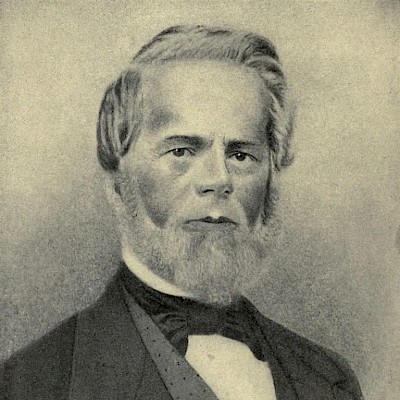Biography of P. P. Quimby
Extracted from a disappeared website. Originally published on 2005.
Phineas Parkhurst Quimby, who was known as "Park," was born on February 16, 1802, in Lebanon, New Hampshire. He was apprenticed as a clockmaker and had little traditional education. Several important elements of his life led to the development of his ideas of mental healing.
The first important milestone was when Quimby developed tuberculosis but became disillusioned with the method of treatment prescribed by his physician and gave up hope of recovery. A friend suggested that he take up a physical outdoor activity such as horseback riding to improve his condition. While his severe physical ailments prevented him from trying this suggestion, Quimby tried the next best thing and embarked on carriage trips. This course of action produced remarkable results and his recovery prompted much thought on the matter. However, he did not pursue this further until several years later.
In 1838, Quimby began studying Mesmerism after attending a lecture by Doctor Collyer and soon began further experimentation with the help of Lucius Burkmar, who could fall into a trance and diagnose illnesses. Quimby again saw the mental and placebo effect of the mind over the body when medicines prescribed by Burkmar, with no physical value, cured patients of diseases. From the conclusions of these studies, Phineas Quimby developed theories of mentally aided healing and opened an office in Portland, Maine in 1859. Among the students and patients who joined his studies and helped him to commit his teachings to writing were Warren Felt Evans, Annetta Seabury Dresser and Julious Dresser, the founders of New Thought as a named movement, and Mary Baker Eddy, the founder of the Christian Science movement.
Warren Felt Evans was one of the first individuals which wrote seriously on the teachings of Phineas Quimby. Though unlike some other students, he did not specifically establish a movement under these teachings but he did, in fact, open a practice in Salisbury, Massachusetts. Although the most important gift that Evans left to New Thought was his written work, Evans also took the important step of integrating the philosophies of Swedenborg and Quimby.
Although Warren Felt Evans focused on producing written works on the issues, and Annetta and Julius Dresser did not address their own learnings immediately, Mary Baker Eddy (formerly known as by the surname Patterson) developed a movement out of the ideas she derived from Quimby's teachings. Through the treatment for her poor health, Eddy came to be a student of Phineas Quimby and out of this came her own unique ideas about metaphysical healing. In 1862, Eddy received treatment from Quimby and was cured quickly. Though her health tended to fluctuate, when she practiced the latter techniques her condition improved. Though the commonalities between their work are quite apparent, Eddy had to personally integrate her own Christian faith with Quimby's ideas since he tended to be critical of traditional religious practices.
In 1879 practioners assembled the Church of Christ, Scientist and soon ordained Eddy as the pastor. At this point the controversy that delineated the split between New Thought and Christian Science was characterized by the dispute between Mary Baker Eddy and Edward J. Arens, her former student, and Julius Dresser, who continued along with his wife and son to dispute Eddy over the origin of certain ideas. However, Christian Science and Mary Baker Eddy weathered the storm of plagiarism accusations and the movement still survives today. Annetta and Julius Dresser continued their attack on Eddy throughout the rest of their lives.
Dr. Quimby died on Jan. 16, 1866, at his residence in Belfast Maine, where he lived most of his life, at the age of sixty-four years, and was the result of too close application to his profession and of overwork. A more fitting epitaph could not be accorded him than in these words:-- "Greater love hath no man than this, that a man lay down his life for his friends." For, if ever a man did lay down his life for others, that man was Phineas Parkhurst Quimby.
Horatio W. Dresser, son of Annetta Julius Dresser, explained Quimby's ideas in a seven element list.
1. The omnipresent Wisdom, the warm, loving Father of us all, Creator of all the universe, whose works are good, whose substance is an invisible reality.
2. The real man, whose life is eternal in the invisible kingdom of God, whose senses are spiritual and function independently of matter.
3. The visible world, which Dr. Quimby once characterized as "the shadow of Wisdom's amusements"; that is, nature is only the outward projection or manifestation of an inward activity far more real and enduring.
4. Spiritual matter, or fine interpenetrating substance, directly responsive to thought and subconsciously embodying in the flesh the fears, beliefs, hopes, errors, and joys of the mind.
5. Disease is due to false reasoning in regard to sensations, which man unwittingly develops by impressing wrong thoughts and mental pictures upon the subconscious spiritual matter.
6. As disease is due to false reasoning, so health is due to knowledge of the truth. To remove disease permanently, it is necessary to know the cause, the error which led to it. "The explanation is the cure."
7. To know the truth about life is therefore the sovereign remedy for all ills. This truth Jesus came to declare. Jesus knew how he cured and Dr. Quimby, without taking any credit to himself as a discoverer, believed that he understood and practiced the same great truth or science.
